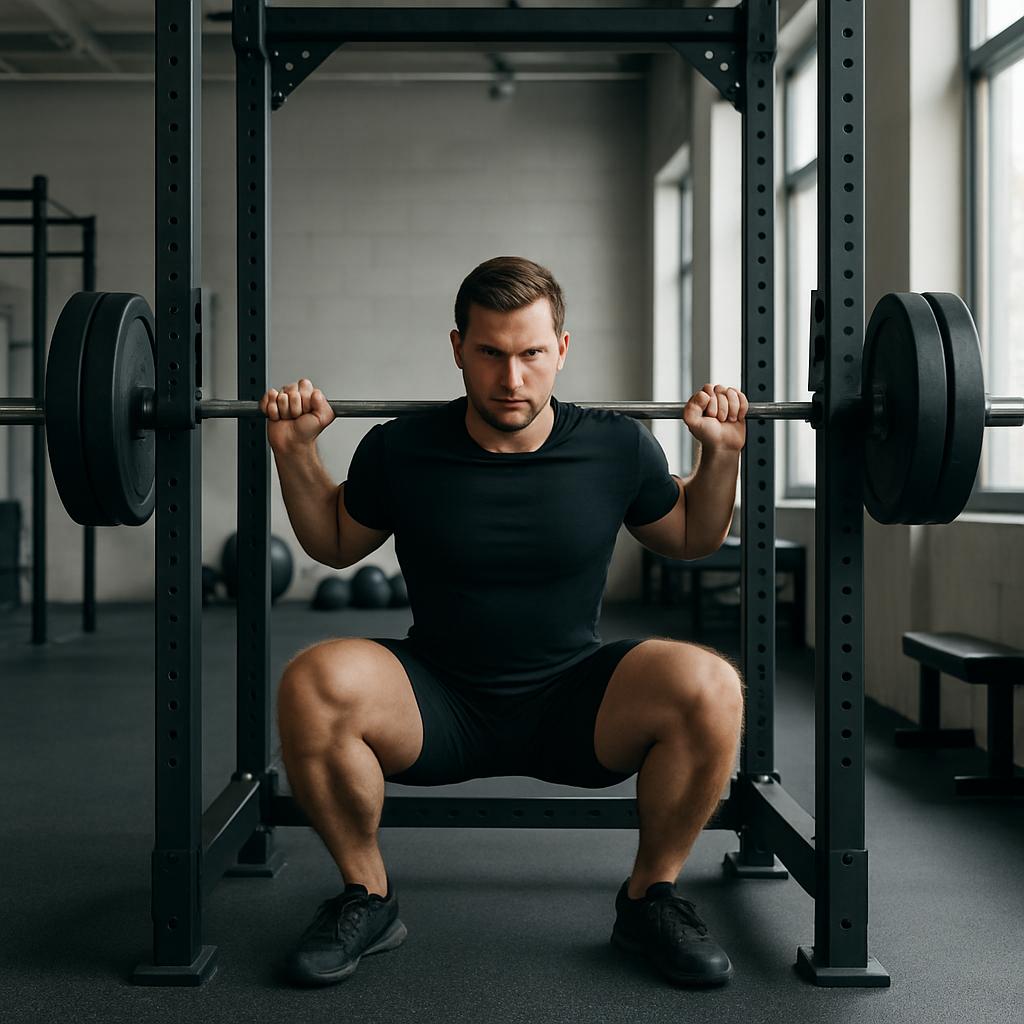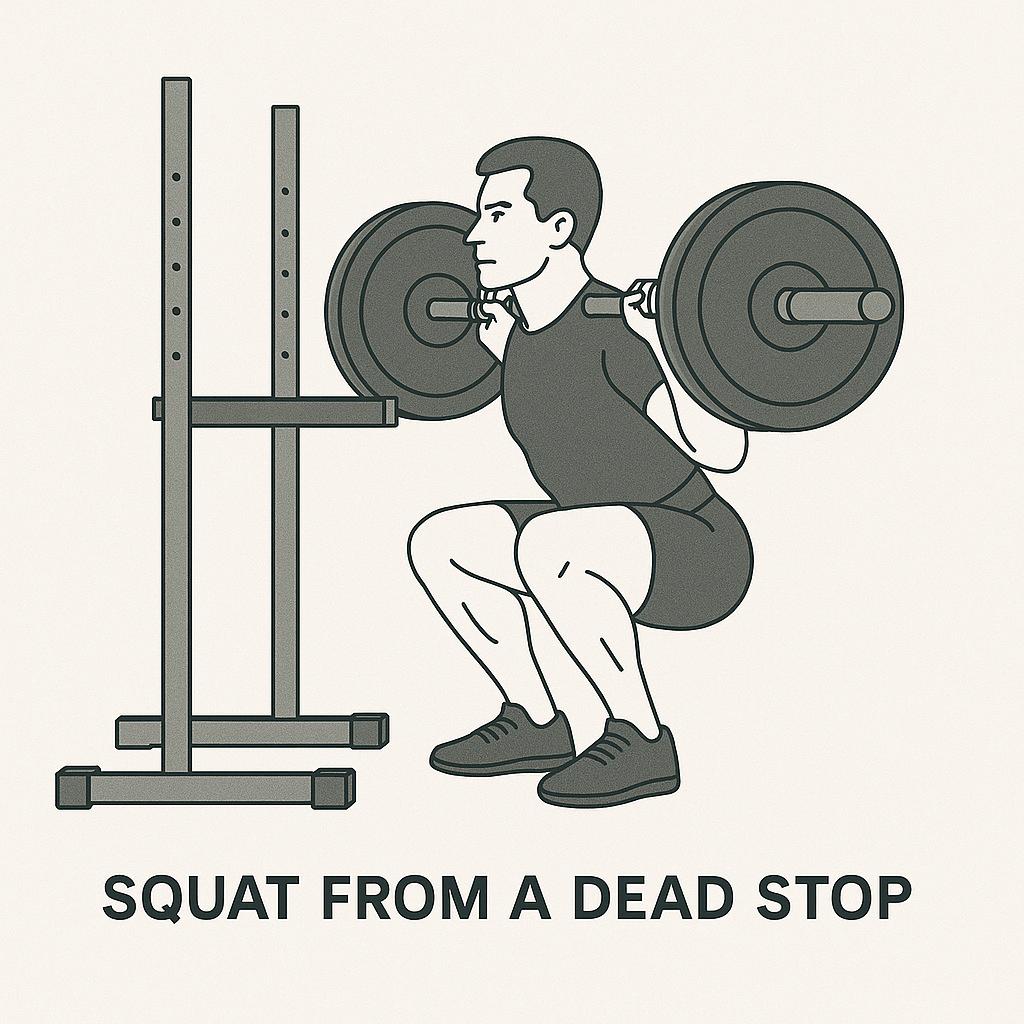The Anderson squat is a unique squat variation performed from a dead stop, focusing entirely on raw power and eliminating the stretch reflex. Unlike traditional squats, you begin each rep from the bottom position, starting from pins or blocks, which forces your muscles to work harder and develop starting strength. Understanding the Anderson squat is essential for lifters aiming to break through plateaus, build explosive strength, and improve lower body power. This guide will quickly explain what the Anderson squat is, how to perform it safely, key benefits, drawbacks, and who it’s best for.

What Is the Anderson Squat?
The Anderson squat, named after legendary lifter Paul Anderson, is a squat variation performed from a dead stop at the bottom position. Instead of starting with the bar on your back and squatting down, you set the loaded barbell on safety pins in a power rack—usually just below parallel. Each repetition begins with the bar at rest, so you must drive up without momentum. This movement is designed to improve starting strength, concentric power, and technique out of the “hole” (deepest point of the squat).

- Key Difference: Removes the eccentric (lowering) phase at the start of each rep.
- Setup: Barbell rests on pins at your chosen depth.
- Target: Hip drive, leg power, core and back stability.
Why it matters: The Anderson squat eliminates reliance on the stretch reflex, helping athletes identify and fix weaknesses in their squat or deadlift starting position (BarBend, 2024).
How To Do the Anderson Squat (Step-By-Step)
Proper technique is crucial for safety and effectiveness. Here’s how to set up and perform the Anderson squat:
1. Equipment Setup
- Use a sturdy squat rack or power cage with safety pins.
- Set the pins to your desired depth (usually just below parallel or at your sticking point).
- Load the barbell with your working weight.
2. Starting Position
- Position yourself under the bar with your usual squat stance.
- The bar should rest across your upper back, and your feet shoulder-width apart.
3. Bracing and Lift
- Take a deep breath, brace your core, and grip the bar tightly.
- With no downward movement, drive upward explosively from the pins.
- Fully extend your hips and knees at the top.
4. Reset for Each Rep
- Lower the bar with control back to the pins.
- Allow the bar to come to a full stop before starting your next rep.
- Repeat for your programmed number of repetitions.
Tip: Do not bounce or jerk the bar off the pins—each rep should start from a true dead stop (PowerliftingTechnique, 2024).
Benefits of the Anderson Squat
Why should you add Anderson squats to your routine? Here are the main advantages:
- Increases Starting Strength: By removing the stretch reflex, your muscles generate all the force, improving power from the bottom position (Westside Barbell, 2024).
- Targets Sticking Points: Perfect for lifters struggling at the bottom of the squat or deadlift.
- Builds Explosive Power: Enhances force development for athletes in powerlifting, football, or track and field (BarBend, 2024).
- Improves Hip and Core Stability: The static setup challenges your trunk, glutes, and lower back.
- Reveals Weaknesses: Pinpoints technical flaws, improving overall squat mechanics.
- Useful for Rehabilitation: Starting from a static position can reduce strain on certain joints for some athletes (always consult a medical professional first).
Statistics: Many elite strength athletes use Anderson squats to break through plateaus—studies show concentric-only movements can boost maximal force output by up to 15% (NSCA, 2018).
Drawbacks and Risks
Despite the benefits, the Anderson squat may not suit everyone. Key considerations:
- Requires a Power Rack: Not practical in basic gyms without adjustable safety pins.
- Complex Setup: Bar placement and height must be precise to avoid injury or poor technique.
- Risk of Technical Breakdown: If you lose core tension, the movement can turn into a “good morning” and strain your back (PowerliftingTechnique, 2024).
- Can Be Hard on Joints: The lack of stretch reflex and immediate force output can stress the hips and lower back, especially with heavy weights (T-Nation, 2023).
- Not for Beginners: Best for experienced lifters with good mobility and body awareness.
Safety tip: Always warm up thoroughly and use moderate loads when learning this movement.
Who Should Use the Anderson Squat?
- Powerlifters and Olympic lifters looking to fix squat or deadlift weaknesses.
- Athletes needing more explosive lower-body strength (e.g., football, rugby, track).
- Experienced gym-goers breaking through plateaus.
- NOT recommended for new lifters, those with significant mobility issues, or without access to proper equipment.
For further guidance, consult your coach or reference official resources for safe programming.
Alternatives and Variations
If the Anderson squat isn’t suitable for you, try these:
- Pin Squat: Pause the bar briefly on the pins during the squat’s descent, then drive up.
- Box Squat: Sit back onto a box to develop hip drive.
- Partial Anderson Squat: Adjust pin height to target different sticking points.
- Zercher Anderson Squat: Hold the bar in your elbows for an extra core challenge.
Each variation offers unique benefits and can complement traditional squats.
Frequently Asked Questions
Q: How often should I do Anderson squats?
A: 1–2 times per week is sufficient for most lifters. Program as an accessory lift, not your main squat.
Q: Are Anderson squats safe for the knees and back?
A: Yes, if performed with correct form, proper equipment, and moderate weights. Start light and progress gradually.
Q: Can beginners try the Anderson squat?
A: It’s better suited for intermediate to advanced lifters. Beginners should master regular squats first.
For more, see the PowerliftingTechnique FAQ.
Conclusion
The Anderson squat is a powerful tool for increasing starting strength, fixing squat weaknesses, and boosting athletic power. While it requires proper setup and experience, the benefits can be game-changing for serious lifters. Ready to break through your squat plateau? Try adding Anderson squats to your training routine and feel the difference.
